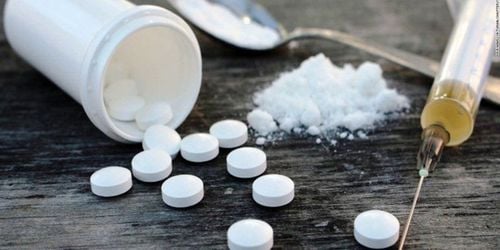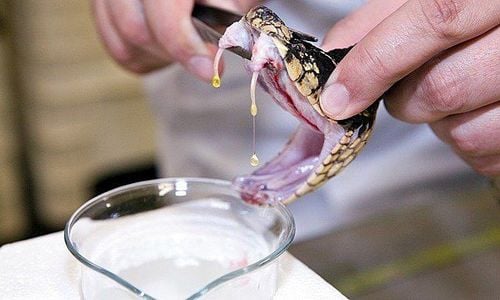This is an automatically translated article.
The article was professionally consulted with Specialist Doctor I Nguyen Huu Nam - Pediatrician - Neonatologist - Department of Pediatrics - Neonatology - Vinmec Nha Trang International General Hospital.Diaphragm laxity is a congenital disease caused by a defect in the muscle part. The diaphragm in patients with this disease is just like a thin membrane, so the abdominal organs will push the diaphragm upwards, taking the place of the lungs. The current treatment method for diaphragmatic flaccidity is thoracic endoscopic surgery. This is a highly effective treatment with a good prognosis.
1. In what cases is thoracic endoscopic treatment of diaphragmatic flaccidity used?
Diaphragmatic effusion is a congenital malformation that requires surgery but is not emergency surgery. The time of surgery will be consulted and decided by the doctors of the intensive care unit, the anesthesiology department and the surgeon. Thoracic endoscopic surgery is indicated in cases where the patient is diagnosed with diaphragmatic flaccidity through chest X-ray, contrast-enhanced transit, and chest CT scan. In addition, this laparoscopic method of diaphragmatic flabby treatment is also contraindicated in the following cases:Patients with complex heart defects such as arterial descent, atrioventricular septal defect, hypoplasia left ventricle. Patients with severe respiratory failure or pneumonia.
2. What to prepare for diaphragmatic flabby treatment by thoracic surgery?
2.1. Performer The thoracoscopy technique for diaphragmatic flabby treatment is performed by experienced endoscopic surgeons, technicians and nurses.Before performing the technique, the doctor needs to prepare some issues as follows:
The doctor needs to evaluate the patient before surgery: The degree of respiratory failure, accompanying malformations (20%), pneumonia, jaundice.. The doctor supports the patient's breathing with an endotracheal tube, do not use a breathing mask because the gas entering the digestive tract causes more severe lung compression. Establish an intravenous line. Doctors need to pay attention to correct electrolyte disorders, acid-base problems, detect and treat hypoglycemia. Prophylactic antibiotics, intravenous vitamin K. 2.2. Means of performing technical procedures: Endoscopic thoracic surgery for diaphragmatic flabby treatment is performed with the following equipment:
Camera and screen system. Pumping system for washing thoracic cavity and pumping system for CO2. Instruments include: 3 5 mm trocars, 1 0 degree optic, 1 5 mm endoscopic pin, 1 5 mm cauterization hook, 1 laparoscopic needle clamp, 2 endoscopic bowel clamps and diaphragm patch. 2.3. Patient: Before surgery, the patient is carefully prepared and diagnosed with diaphragmatic laxity. The doctor needs to explain to the patient about the condition and the possibility of switching to open surgery.
2.4. Patient records Patient medical records are prepared in accordance with regulations of the Ministry of Health.
3. How is thoracic surgery to treat musculoskeletal laxity performed?
The steps to perform thoracic surgery to treat flaccid diaphragm are as follows:3.1. Checking the medical record The doctor checks the patient's medical record to ensure that the test results and diagnosis are complete.
3.2. Examination of the patient The patient must be prepared for surgery according to the correct procedure.
3.3. Performing technical procedures The doctor conducts endotracheal anesthesia according to the following steps:
Initiating anesthesia according to the procedure:
Hypnovel: 0.5 mg/kg, maintaining 0.3 mg/kg/hour. Fentanyl: 10-20 mcg/kg, maintenance 10 mcg/kg/hour. Nocuron: 0.2 mg/kg, maintain 0.2 mg/kg/hour. The doctor maintains the ventilator and vasopressor parameters as before surgery, after the patient is placed in the surgical position, the indicators are continuously monitored, when the blood is checked at the time before surgery, after injecting CO2 into the pulmonary vascular space 15 minutes, 30 minutes, 45 minutes and after removing CO2 at the end of surgery. Maintenance: The physician maintains mean arterial pressure > 45 mmHg.
Respiratory: Maintain peak airway pressure < 25 cm H2O, SpO2 pre-ductal > 90% and PCO2 < 60 mmHg.
After anesthetizing the patient, the doctor conducts surgery according to the following steps:
Patient position: The patient is lying on his side 90 degrees. Position of the operating team: The surgeon and the operating assistant stand at the patient's head. Location of trocar: The doctor uses 3 trocars to perform surgery, the first troca is placed through the intercostal space in the middle axillary line for the bronchoscope, the second troca is placed in the 4th intercostal space at 1-2 distances from the nipple line. cm, the third troca was placed through the 4th intercostal space behind the scapula process. Doctors use inflatable pressure from 4-6 mmHg. The surgeon observes and assesses the contents of the hernia. The doctor sutures the diaphragmatic folds with indigestible stitches so that the diaphragm is moderately stretched and the lungs are well enlarged. The doctor performed a thoracic drainage, then withdrew the troca and sutured the troca hole.
4. Follow-up after thoracic surgery to treat flaccid diaphragm
After performing thoracoscopic surgery for diaphragmatic flabby treatment, the doctor needs to monitor the patient's condition with the following indicators:Blood gas indexes. Pulmonary arterial hypertension. Expanded lung condition. Monitor the patient and take care of chest drainage.
5. Complications and treatment
Some complications that may be encountered after thoracoscopic surgery for diaphragmatic flabby treatment are as follows:Intestinal perforation: During the suturing process, the doctor may sew on the intestines, causing intestinal perforation. This complication is often detected after surgery due to peritonitis, and is treated as peritonitis due to intestinal perforation. Spleen and liver bleeding due to suturing to the organ: The doctor assesses the hemodynamics after surgery, if stable, continues to monitor, if blood pressure drops, the doctor conducts emergency laparotomy to stop the bleeding. Diaphragmatic effusion is a birth defect that requires surgery. Accordingly, the time of surgery will be consulted and decided by the doctors of the intensive care unit, the anesthesiology department and the surgeon.
Follow Vinmec International General Hospital website to get more health information, nutrition knowledge, beauty to take care of yourself and loved ones in your family.
Please dial HOTLINE for more information or register for an appointment HERE. Download MyVinmec app to make appointments faster and to manage your bookings easily.













